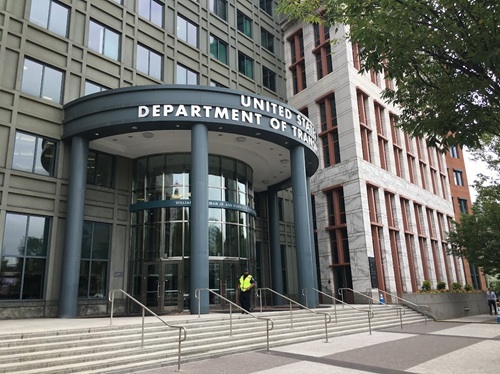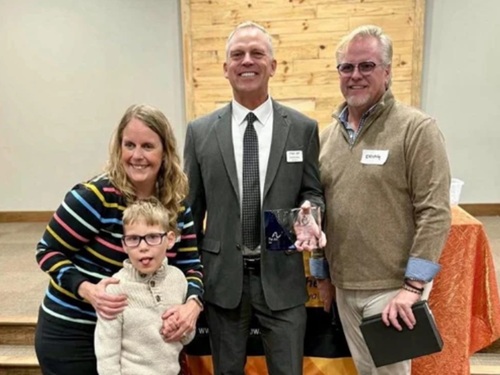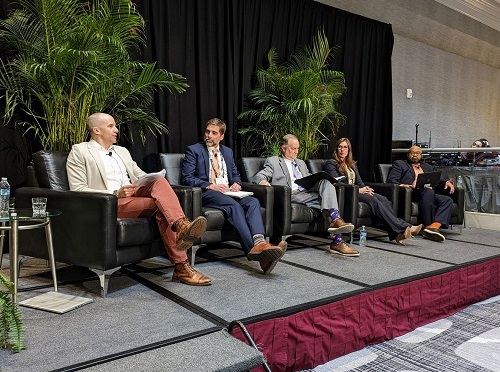While a transportation agency’s direct influence on greenhouse gas or GHG emissions varies from state to state, all state departments of transportation have an important role to play in efforts to de-carbonize the nation’s mobility networks.
[Above photo by AASHTO]
That served as the main idea for a knowledge session held during the American Association of State Highway and Transportation Officials 2023 Washington Briefing, held February 28 through March 3 in Washington, D.C.

Nate Hill – head of U.S. energy policy for Amazon, which sponsored the session – noted that the nation’s transportation sector accounts for 27 percent of overall GHG emissions and, together with the electric power industry, remains one of the largest contributors of GHG in the country.
He explained that state and local transportation agencies are taking a variety of actions to decarbonize the mobility sectors under their purview, such as improving active transportation systems, the expansion and electrification of public transit, the electrification of fleets, and efficiency improvements to shipping and freight.
Eric Boyette, secretary of the North Carolina Department of Transportation, pointed to the recent draft of his agency’s N.C. Clean Transportation Plan as an example of how state DOTs like his are trying to reduce GHG emissions.

“For me, every time throughout my career when my agency faced challenges, we found a way to overcome those challenges every time. And de-carbonization is no different,” Boyette explained. “We know we can’t do this alone – we have to have partners, especially in private sector. We have to look at multimodal usage and how we work with municipalities on issues such as EV [electric vehicle] charging and how to support that. Look at all the different pieces [of de-carbonization] and how put together all boils down to communication with partners and citizens.”
Tim Sexton – assistant commissioner for sustainability, planning, and program management for the Minnesota Department of Transportation – made a similar point.

“We created a sustainable transportation advisory council made up of elected officials, health officials, and others,” Sexton said. “They provide recommendations to us and while we do not accept all of them, they challenged us and reflect our commitment to engage on EVs, sustainable aviation fuel, climate resilience, and reducing miles traveled.”
He also believes climate change and transportation are both health issues and thus connected through de-carbonization efforts. “It’s important to understand that through de-carbonization, the lines between transportation and the electricity sector, and broadband, and transit, and many other sector – those lines are blurring.”
Connected to those “blurred lines” is the issue of broadening the transportation data said to develop bigger de-carbonization strategies, noted Gregg Steverson, deputy director of the Fairfax County Department of Transportation.

“It is going to be very interesting how we move this forward,” he said. “Take the traffic impact analysis we conduct for land-use planning purposes. If the only thing we look at in that transportation analysis is traffic congestion, we’re missing the mark – we’re not including transit or active transportation. That’s why we must incorporate measures for other modes – bike, pedestrian, transit – and put them together with [vehicle] traffic to create overall modal analysis.”
He said that’s all part of trying to change the “transportation mindset” toward a multimodal perspective. “It’s about changing the perception of the convenience of the vehicle so we can put in the right routes for transit, biking or walking, so it can be safe and convenient to use those modes while making them accessible for those with disabilities,” Steverson noted. “It is about trying to get that mindset changed to what they perceive as the best way to get from point A to point B.”

Cathie Vick, chief development and government affairs officer for the Virginia Port Authority, noted that her agency is working more closely with state DOTs to create more multimodal opportunities for freight shipments and thus help lower vehicle-based GHG emissions.
“We’re expanding out barge and rail intermodal systems to help take trucks off the road – and we’ve been doing a lot of things like that because it is the right thing to do,” she said. “We’re also preparing to add a lot of transload and crossdock services due to a shift in cargo volumes from the west coast to the east coast.”
Vick noted one major issue when it comes to de-carbonization efforts is that the technology is often not keeping pace with the desire; something she is seeing in the port equipment space.
“It is hard to retire equipment if replacement units are not ready,” Vick said. “However, we keep looking at every piece of equipment we use or touch over course of the year to see how we can reduce carbon emissions. This does not come without challenges – but if we work together towards that vision, we can get there.”
 Top Stories
Top Stories
USDOT Issues $1B in Local Road Safety Funding
January 2, 2026 Top Stories
Top Stories

